One of the privileges of living in the North country is getting the occasional glimpse of the Northern Lights.
Having the chance to witness in person the beauty of the Aurora Borealis, a truly awe-inspiring display of nature, should be on everyone’s bucket list. Only a few locations in the United States fall within the auroral zone and can provide the necessary elements for viewing the Northern Lights. To catch the overhead extravaganza, where the sky is filled with dancing multi-colored bands of light, you have to plan ahead but understand it still comes down to chance. No location, or given night, guarantees this amazing experience. However, we can provide a few suggestions that can dramatically increase your chances.
Tips for Seeing the Aurora Borealis
Scheduling your trip at the right time of year is key. Late September and March is prime activity season. Peaks occur during these two months due to the fall and spring equinoxes. The Northern Lights are spotted at all times throughout the night, but are most likely to occur around 10-11 PM. Choose a location with clear skies and dark surroundings far from city lights, as this improves how bright the lights will appear to shine.
Consider camping or a least staying in a travel trailer or your roof top camper (see our piece on the best roof top tents here) to increase your odds of being around when the lights decide to dance.
5 Great Places in the U.S. ToSee the Aurora Borealis
Armed with these basic strategies, we’ll discuss 5 great places in the United States you can take advantage of for a chance at enjoying a night beneath the Aurora Borealis.
Gunflint Trail – Cook County, MN
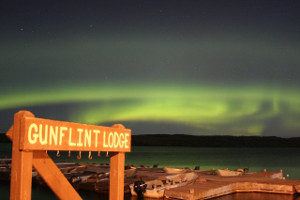 Cook County lies at the northeastern edge of Minnesota along the border with Canada, ideal for catching a glimpse of the Northern Lights. It is home to the Boundary Waters Canoe Area Wilderness (BWCAW), which was named one of the “50 Places of a Lifetime” by National Geographic. This nature area includes many great attractions including Oberg Mountain, Lake Superior, Oberg Lake, Moose Mountain, and High Falls of the Pigeon River (Minnesota’s tallest waterfall at 120 ft.). the Superior Hiking Trail is a great trail to through-hike the area. If you choose to explore area by water, get ready to paddle in a canoe or kayak. Many of the lakes are paddling only and offer gorgeous backdrops for viewing the Aurora Borealis.
Cook County lies at the northeastern edge of Minnesota along the border with Canada, ideal for catching a glimpse of the Northern Lights. It is home to the Boundary Waters Canoe Area Wilderness (BWCAW), which was named one of the “50 Places of a Lifetime” by National Geographic. This nature area includes many great attractions including Oberg Mountain, Lake Superior, Oberg Lake, Moose Mountain, and High Falls of the Pigeon River (Minnesota’s tallest waterfall at 120 ft.). the Superior Hiking Trail is a great trail to through-hike the area. If you choose to explore area by water, get ready to paddle in a canoe or kayak. Many of the lakes are paddling only and offer gorgeous backdrops for viewing the Aurora Borealis.
The Gunflint Trail is a 57-mile paved road winding through the hills of Superior National Forest. Along this path are resorts, campsites, and lake equipment supply houses. It is a great place for fishing, hiking, dog-sledding, snowmobiling, and cross-country skiing. Many people also enjoy the opportunity for wildlife sightings, as this area is full of birds, moose, deer, bears, wolves, and much more. Sprawling natural forests, pristine bodies of water, and endless miles of wilderness are here for your enjoyment. It is not hard to imagine why Minnesota tops the list!
Denali National Park and Preserve – Fairbanks, AK
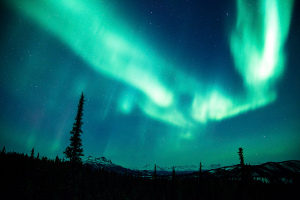 Fairbanks, Alaska, is considered the most likely place in the United States to witness the Northern Lights. Given Alaska’s geographical location compared to the other 49 states, it’s easy to understand why this is true. Fairbanks is right up against the all-important 65th parallel in its latitude, the point where Northern Lights tend to be commonplace when conditions are favorable. Fairbanks also serves as the home of the Geophysical Institute of Alaska, which offers forecasts for Northern Light activity. Another great reason this city is made for watching the night sky: you can do it from a hot spring bath!
Fairbanks, Alaska, is considered the most likely place in the United States to witness the Northern Lights. Given Alaska’s geographical location compared to the other 49 states, it’s easy to understand why this is true. Fairbanks is right up against the all-important 65th parallel in its latitude, the point where Northern Lights tend to be commonplace when conditions are favorable. Fairbanks also serves as the home of the Geophysical Institute of Alaska, which offers forecasts for Northern Light activity. Another great reason this city is made for watching the night sky: you can do it from a hot spring bath!
The Denali National Park and Preserve is a 2.5 million hectare wilderness that is brimming with untouched beauty. Located well within the auroral zone and away from major civilization, its remote scenery is the perfect and pristine location for your Aurora Borealis hunt offering plenty of room for you to set up your own personal viewing space. Perfect for hiking and camping, this park offers huge open spaces, mountain vistas, and an abundance of wildlife. Some of that wildlife could be dangerous, so be prepared. We did a piece on the best bear spray, which might not be a bad idea considering you are in grizzly country!
Upper Peninsula, MI
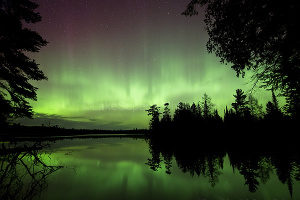 The Upper Peninsula of Michigan is another great area to experience the Northern Lights. Extending out into Lake Superior, the Upper Peninsula is one of the most northernmost parts of the continental United States. Not only can you see the amazing lights in the sky, but also mirrored off the largest lake in North America. This region is known for its large variety of boating, hiking, and camping opportunities. Many excellent wilderness adventures await including visiting Pictured Rocks National Lakeshore, Headlands International Dark Sky Park, and the Whitefish Point Light Station.
The Upper Peninsula of Michigan is another great area to experience the Northern Lights. Extending out into Lake Superior, the Upper Peninsula is one of the most northernmost parts of the continental United States. Not only can you see the amazing lights in the sky, but also mirrored off the largest lake in North America. This region is known for its large variety of boating, hiking, and camping opportunities. Many excellent wilderness adventures await including visiting Pictured Rocks National Lakeshore, Headlands International Dark Sky Park, and the Whitefish Point Light Station.
If you are on the west side of Lake Michigan, the tip of Door County in Wisconsin can be great took given that it is a recognized Dark Sky area. It is a bit south of the Upper Peninsula but not by much.
If you are lucky enough to be here on a clear night with an Aurora forecast, consider heading to the Lake Superior shoreline away from any towns, bring your camera in a camera sling to keep it safe, and fix your eyes to the North. The big lake provides a perfect vantage point for watching Northern Lights.
National Wildlife Refuge – Aroostook County, ME
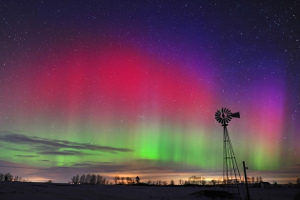 Located on the U.S.-Canadian border, Aroostook County, Maine has a very low population density and therefore nice dark starlit and moonlit nights. This absence of light pollution is ideal for those trying to catch a glimpse of the Northern Lights and breath-taking star trails. Tourists are typically drawn to this area for the festivals and events, as well as the chance to partake of fresh Maine lobster. Motorcyclists also regularly come the area to visit Four Corners Park, an important pit stop when planning a road trip to the four corners of the United States.
Located on the U.S.-Canadian border, Aroostook County, Maine has a very low population density and therefore nice dark starlit and moonlit nights. This absence of light pollution is ideal for those trying to catch a glimpse of the Northern Lights and breath-taking star trails. Tourists are typically drawn to this area for the festivals and events, as well as the chance to partake of fresh Maine lobster. Motorcyclists also regularly come the area to visit Four Corners Park, an important pit stop when planning a road trip to the four corners of the United States.
The times when you are going to see Northern Lights — September through April – might not be the best times to visit Maine when it comes to hiking or exploring, but the good news is you could have the place much more to yourself.
The Aroostook National Wildlife Refuge is an immense span of forests, grasslands and wetlands spread across Aroostook County. Its 2,100 hectares provide clear nights for viewing the Aurora Borealis as well as spotting local wildlife. The ability this area offers you to distance yourself from all modern society allows for the clearest possible skies and natural scenery.
Idaho Panhandle National Forest, ID
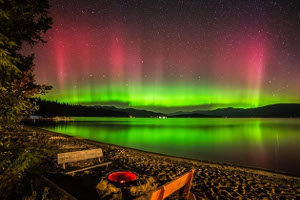 Idaho has a lot more to offer than just potatoes. The Idaho Panhandle National Forest has great potential for the Northern Lights show you are seeking, including the chance of a dual view reflecting off of Priest Lake. This region offers dark, clear skies, with little light pollution and remote locations that are a necessity for the best views of any potential sky show. However, the Aurora Borealis is a fairly rare occurrence here and is only frequently spotted during particularly powerful solar storms.
Idaho has a lot more to offer than just potatoes. The Idaho Panhandle National Forest has great potential for the Northern Lights show you are seeking, including the chance of a dual view reflecting off of Priest Lake. This region offers dark, clear skies, with little light pollution and remote locations that are a necessity for the best views of any potential sky show. However, the Aurora Borealis is a fairly rare occurrence here and is only frequently spotted during particularly powerful solar storms.
Nearby Heyburn State Park is also a good location in Idaho, if the skies are more conducive to it at the time you are going on an Aurora search.







